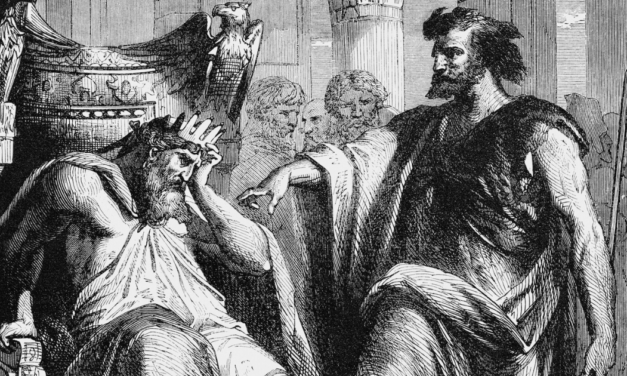This review first appeared in the Christian Research Journal, volume 26, number 1 (2003). For more information about the Christian Research Journal, click here.
A Summary Critique of
The Jesus Mysteries:
Was the “Original Jesus” a Pagan God?
by Timothy Freke and Peter Gandy
(Harmony Books, 2000)
If The Jesus Mysteries had been written 100 years ago, authors Timothy Freke and Peter Gandy might have some excuse for the arguments they present. In the late nineteenth and early twentieth centuries, knowledge of the culture of the Hellenistic and Jewish world was not as complete as it is today, and many scholars believed that the New Testament was heavily influenced by mystery religions and Gnosticism; however, the discovery of the Dead Sea Scrolls, as well as various archaeological findings that confirm the New Testament, have improved our understanding of the historical and cultural context to the point where it is folly to declare that Jesus was not a historical person.1
Freke and Gandy, nevertheless, attempt to prove that the biblical account of Jesus was a myth created by certain early Jewish believers based on the myths of the various mystery religions of the ancient world. They argue that this “earliest,” mythical view of Jesus was held by Gnostic Christians (the authentic Christians according to Freke and Gandy), but rejected by those they call Literalist Christians (those who believe in a literal Jesus), whom we know as the orthodox church. Various Christian rites such as the Lord’s Supper and baptism, they say, were dependent on practices found within the pagan mystery religions. According to the authors, many of the teachings and events ascribed to Jesus were based on similar words and events found in the myths of the various mystery religions, such as Eleusianism, Dionysism, Mithraism, and Orphism. These parallels include Jesus’ virgin birth, His status as Son of God, His triumphal entry, and His death and resurrection, to mention a few.
The authors seek to demonstrate that the biblical accounts of Jesus contain inaccuracies and inconsistencies that make them unreliable historical documents. They further argue that the apostle Paul held views similar to those of the mystery religions and Gnosticism.
These arguments have been answered and disproved in numerous books and articles2; nonetheless, since The Jesus Mysteries has received a wide hearing in the secular press, it is important for us to give consideration to its thesis and provide a response.
Biased Rhetoric. Freke and Gandy present themselves as unbiased investigators seeking an explanation for the parallels they observe. Nothing could be further from the truth. First, the authors, like many who deny the historicity of Jesus and the miraculous events of His life, have an unstated assumption that supernatural intervention in the world is not possible. They assert, for example, “Christianity did not arrive as a unique divine intervention. It evolved from the past, like everything else” (255). This evolutionary theory, like Darwinism (to which they compare it), is based on an unproven assumption of antisupernaturalism, which the authors maintain at all costs.
Second, the authors exhibit an anti-Christian bias in their polemical attacks at a number of points on historic Christianity in general, and the Roman Catholic Church in particular (10–11, 204–205, 209–251). They, for instance, compare the literalist church to Hollywood filmmakers (12), and “Stalin’s propaganda machine…[which] fed its lies to the faithful” (250). They make assertions such as, “Literalist Christianity has actually been the cause of deep divisions: Christians against heathens, men against women, science against religion, faith against reason” (254). Such rhetoric, rather than being the result of documented historic investigation, appears to be the result of the authors’ lifelong “obsession with world mysticism” (3), and a devotion to similar forms of New Age paganism today. They lament, for example, that “the wanton destruction of our Pagan heritage is the greatest tragedy in the history of the Western world” (250). They conclude that “only by returning to its mystical roots will Christianity play a role in the creation of a new spirituality for the New Age of Aquarius” (255). It is certainly possible that a dispassionate examination of historical facts would result in a passionate belief (this is true of many who have come to believe in the historical Jesus), but this does not appear to be the case with Freke and Gandy, as evidenced in the special pleading and fact twisting to which they resort to support their unorthodox conclusions.
Treating Parallels as Dependence. Citing parallels with mystery religions and Gnosticism (they seem not to understand the difference between the two) in order to prove Christianity’s dependence on them is a faulty approach. Social and religious movements often share similar forms of expression or practices. Similarity, however, does not necessarily prove dependence. Many societies in the biblical world (and today) practiced circumcision. Different cultures have believed in gods taking on human form, or in the need of salvation, or in an afterlife. Ritual religious meals and ceremonies of initiation such as baptism are common. These similarities are not unexpected given our common human nature, experience, and desires. What culture, for example, doesn’t view washing in water as a means of cleansing? What is important, however, is not the similarity of the words and practices, but the meanings and significance attached to them.
In order to make a case for dependence it is necessary to demonstrate a similarity in essence and not just form. The authors even assert, “The tales told about the godmen of the Pagan Mysteries are essentially the same, although they take different forms” (4); however, they repeatedly exaggerate formal similarities while ignoring essential differences between the Jesus story and the various pagan myths. They state for example, “Like Jesus, who at his crucifixion is given a crown of thorns, Dionysus was given a crown of ivory” (51). This suggested parallel ignores the significance differences: a crown of thorns was on one occasion only forced on Jesus as a cruel mockery of Him as “King of the Jews,” while a crown of ivory was frequently and willingly worn by both Dionysus and the pagan worshipers as part of pagan ritual. Such “parallels” are merely superficial and do not indicate dependence.
They state, moreover, that “although no single pagan myth completely parallels the story of Jesus, the mythic motifs that make up the story of the Jewish godman had already existed for centuries in the various stories told of Osiris-Dionysus and his greatest prophets” (28). The fact that no single pagan myth completely parallels the Jesus story, however, is an argument for the uniqueness of the Jesus story, not its similarity. More importantly, including any and all the pagan myths with which to find parallels amounts to stacking the deck in favor of Freke and Gandy’s conclusion; it would be odd if similar motifs could not be found with such a number from which to choose. Such a methodology does not demonstrate dependence.
Problems with Sources. The authors say that the mystery religions existed for thousands of years before they were absorbed into Christianity (18). Various mystery religions did exist from early times in Greece; however, it is only after the first century a.d. that we begin to have much data on them. It is more likely, therefore, that the mystery religions, observing the success of orthodox Christianity, began to mimic its beliefs and practices, rather than the other way around as the authors suggest.
Mystery religions, moreover, as indicated by their very name, were secretive societies, especially early on when they were in disfavor. We simply do not have much credible information regarding their beliefs and practices.3
Lastly, although the book contains an impressive plethora of citations, these are largely to secondary literature. This heavy reliance on secondary sources, and particular men such as G. A. Wells (a professor of German, not a biblical scholar), limits the credibility of their analysis.
Ignoring the Hebrew Background. Virtually no attention is given to the rich Hebrew background of the New Testament and early Christianity. Terms such as “mystery,” “Savior,” “sacrificial lamb,” and “resurrection,” rather than coming from the pagan myths as the authors suggest, are actually based on the Jewish beliefs found in the Old Testament; moreover, the Dead Sea Scrolls have shed light on Jewish practices that may lie behind some New Testament concepts such as baptism, community, and bishops.4
The claim that Jewish Christianity borrowed from pagan myths is untenable. Christianity had its origins in Judaism. Like Judaism, it abhorred idolatry, which is ever present in pagan religions. Paul often exhibited this abhorrence (Acts 17:16; 19:24–41; Rom 1:18–23; 1 Cor. 10:14), as did John (1 John 5:21), and the elders and apostles at Jerusalem (Acts 15:29). First century Israel was not a culture open to paganism. The Maccabean wars were fought over such attempts to Hellenize the Jewish people, as was the revolt of a.d. 66. It is simply false to suggest that Palestinian Judaism was a soil in which paganism could grow, regardless of how much more susceptible other portions of the Roman world were.
An Implausible Explanation. Claims regarding the life, ministry, and especially the death and resurrection of Jesus were verifiable in their historical setting. The events in the life of Jesus were confirmable because they were recorded within a generation of their occurrence (not hundreds of years later, as was often true of the mysteries). These were matters not done in a corner (Acts 26:26) and were not cleverly devised tales (1Pet. 2:16), but were testified to by many witnesses (Acts 2:22; 13:30–31). That the claims about Jesus were part of a grand hoax perpetrated by the early Christians, as the authors suggest, is an implausible explanation since they could be easily disproved in such a historical situation. Claims about Jesus’ resurrection, for example, could be easily disproved by a visit to His still-occupied tomb.
Mistakes and Inaccuracies. The authors reveal a poor understanding of issues of history and biblical texts, of which we will examine only a few. Under “sacred mathematics,” the authors say that the name Jesus (Iesous in Greek) is a forced transliteration of the Hebrew name Joshua. They argue, rather, that the numerical value of the letters in the name Iesous totals 888, which was a Pythagorean mathematical formula for a musical scale (116). What significance this would have held for New Testament Christians we are not told. There are examples of such a literary device in the New Testament, but the name of Jesus was never among them. In reality, the transliteration of Yeshua or Yehoshua as Iesous is very natural; the Greek Old Testament (LXX) used this exact transliteration. The New Testament authors were simply following the standard transliteration, not trying a “Jesus code.”
Freke and Gandy argue that the account of Jesus’ virgin birth is based on prior mythology (29), but in fact, before the advent of Christianity, the mystery religions do not speak of a virgin birth. The New Testament (Matt. 1:22–23), furthermore, specifically relates this miraculous birth to the prophecy in Isaiah 7:14.
The authors seek to link the marriage of the mythical figure Dionysus in an “ox stall” (boukolion), from which comes a divine child, with what they say is the birth of Christ in a stable. They argue that “stable” is the Greek word katalemna, meaning “a temporary shelter or cave” (32). The text (Luke 2:7, 12, 16), however, does not say that Jesus was born in a stable, but merely that He was laid in a manger (an animal’s feeding trough). In fact, according to the standard Greek lexicons (i.e., Bauer, Sophocles, Liddell-Scott, LXX [Lust, Eynikel, Hauspie], and Louw-Nida) there is no such word as katalemna, meaning “stable.” The Greek word kataluma means “inn,” and is probably what they meant. This faux pas demonstrates either carelessness of research or ignorance of the Greek language, to which they often refer.
In reference to the death of Christ they make much of Jesus being crucified on March 23 and raised on March 25, dates allegedly having pagan significance (55). This dating is in error. According to the Synoptic Gospels, Jesus was crucified on Nisan 15, which would be April 8 in a.d. 30 and April 4 in a.d. 33 (the two possible years in which Christ could have been crucified, depending on which year is accepted as the year of His birth).5
The authors assert that the mystery religions had existed for thousands of years before they were absorbed into Christianity (22–24). There is not a shred of historical evidence, however, to support this. The earliest knowledge of any mystery religions is the seventh century b.c., though certainly elements existed prior to the mystery religions that were later taken over by them.
Finally, the authors argue that discrepancies in the Gospel accounts prove that the events were not historical (139–144). Solutions to these apparent discrepancies have been argued in numerous books on Bible difficulties.6 Failing to even acknowledge these proposed solutions, let alone refute them, betrays the authors’ inability to deal seriously or honestly with current scholarship or with arguments that contradict their theory.
Paul a Gnostic? Freke and Gandy consider Paul an advocate of the mystery religions and an early Gnostic (159–175). They do this in part because of his terminology and in part because of elements of his theology, such as baptism. Paul’s use of the Greek word for mystery (mysterion) is taken by them as evidence of his borrowing from the mystery religions; however, this word is found in the book of Daniel and in the literature of Second Temple Judaism, as well as in the teaching of the Hebrew Scriptures. The New Testament usage of the word, moreover, is quite different from that found in the mystery religions or Gnosticism. The Christian “mystery” is for all the people of God to know after it has been revealed by God to the prophets or apostles, not just for a select few as in the mystery religions and Gnosticism. Baptism is also different in the New Testament, for it is connected to repentance from sins, unlike the Greek religions. It is true that mystery terminology is found in the Pauline corpus, but Paul uses it to expose the falsity of pagan religion.
The authors consider Paul to have known nothing of the historical Jesus. That this is not true may be seen from Paul’s specific claims that Jesus had a physical birth (Gal. 4:4); was an Israelite (Rom. 9:5; Gal. 3:16); was of the tribe of David (Rom. 1:3); had a brother by the name of James (Gal. 1:19); was poor (2 Cor. 8:9); ministered among the Jews (Rom. 15:8); had twelve disciples (1 Cor. 15:5); instituted a memorial supper for His disciples (1 Cor. 11:23–27); was crucified, buried, and rose again; and was seen by a great number of people after His physical resurrection (1 Cor. 1:23; 15:4–8; 2 Cor. 13:4; Gal. 3:1, 13).
The Jesus Mysteries is rife with many more examples of bias, inaccuracy, and improper understanding of historical information. It is doubtful that many Christians will accept their thesis (those the authors consider fundamentalists and unwilling to look at the evidence), but others may accept it and thus become less responsive to the Gospel of Jesus Christ that is rooted in unique, historical events. May this brief analysis help readers interact positively with unbelieving friends who may be affected by this misbegotten book.
— reviewed by H. Wayne House
NOTES
- See Randall Price, Secrets of the Dead Sea Scrolls (Eugene, OR: Harvest House, 1996); Randall Price, The Stones Cry Out (Eugene, OR: Harvest House, 1997); Paul Barnett, Jesus and the Rise of Early Christianity (Downers Grove, IL: InterVarsity Press, 1999); Gary Habermas, The Resurrection of Jesus (Grand Rapids: Baker, 1996); Paul Maier, In the Fullness of Time (Grand Rapids: Kregel, 1998).
- See Ronald H. Nash, The Gospel and the Greeks: Did the New Testament Borrow from Pagan Thought? (Richardson, TX: Probe Books, 1992); Edwin Yamauchi, Pre-Christian Gnosticism (Grand Rapids: Eerdmans, 1973); Bruce M. Metzger, “Methodology in the Study of the Mystery Religions and Early Christianity,” chap. 1 in Historical and Literary Studies: Pagan, Jewish, and Christian (Grand Rapids: Eerdmans, 1968).
- H. Wayne House, “Tongues and the Mystery Religions of Corinth,” Bibliotheca Sacra 140, 558 (1983): 134–44.
- See Joseph A. Fitzmyer, The Semitic Background of the New Testament (Grand Rapids: Eerdmans, 1997).
- See Harold W. Hoehner, Chronological Aspects of the Life of Christ (Grand Rapids: Zondervan, 1979), 65–114.
- See Norman L. Geisler and Thomas A. Howe, When Critics Ask: A Popular Handbook on Bible Difficulties (Wheaton, IL: Victor Books, 1992); Gleason L. Archer, Encyclopedia of Bible Difficulties (Grand Rapids: Regency, 1982).








